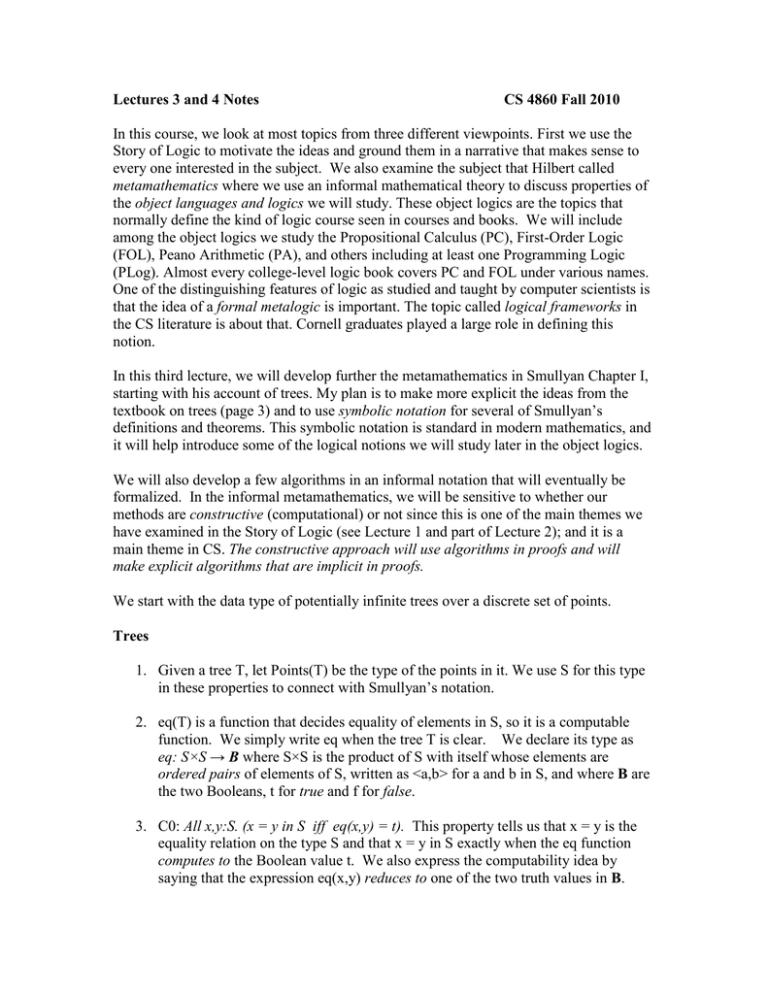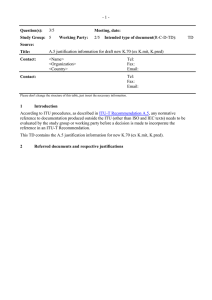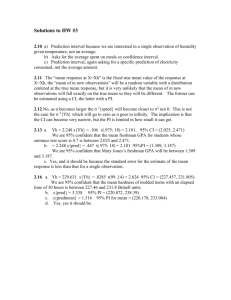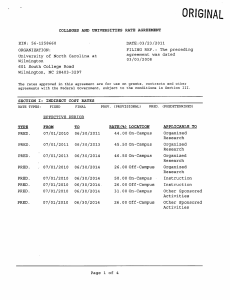Document 15642957
advertisement

Lectures 3 and 4 Notes
CS 4860 Fall 2010
In this course, we look at most topics from three different viewpoints. First we use the
Story of Logic to motivate the ideas and ground them in a narrative that makes sense to
every one interested in the subject. We also examine the subject that Hilbert called
metamathematics where we use an informal mathematical theory to discuss properties of
the object languages and logics we will study. These object logics are the topics that
normally define the kind of logic course seen in courses and books. We will include
among the object logics we study the Propositional Calculus (PC), First-Order Logic
(FOL), Peano Arithmetic (PA), and others including at least one Programming Logic
(PLog). Almost every college-level logic book covers PC and FOL under various names.
One of the distinguishing features of logic as studied and taught by computer scientists is
that the idea of a formal metalogic is important. The topic called logical frameworks in
the CS literature is about that. Cornell graduates played a large role in defining this
notion.
In this third lecture, we will develop further the metamathematics in Smullyan Chapter I,
starting with his account of trees. My plan is to make more explicit the ideas from the
textbook on trees (page 3) and to use symbolic notation for several of Smullyan’s
definitions and theorems. This symbolic notation is standard in modern mathematics, and
it will help introduce some of the logical notions we will study later in the object logics.
We will also develop a few algorithms in an informal notation that will eventually be
formalized. In the informal metamathematics, we will be sensitive to whether our
methods are constructive (computational) or not since this is one of the main themes we
have examined in the Story of Logic (see Lecture 1 and part of Lecture 2); and it is a
main theme in CS. The constructive approach will use algorithms in proofs and will
make explicit algorithms that are implicit in proofs.
We start with the data type of potentially infinite trees over a discrete set of points.
Trees
1. Given a tree T, let Points(T) be the type of the points in it. We use S for this type
in these properties to connect with Smullyan’s notation.
2. eq(T) is a function that decides equality of elements in S, so it is a computable
function. We simply write eq when the tree T is clear. We declare its type as
eq: S×S → B where S×S is the product of S with itself whose elements are
ordered pairs of elements of S, written as <a,b> for a and b in S, and where B are
the two Booleans, t for true and f for false.
3. C0: All x,y:S. (x = y in S iff eq(x,y) = t). This property tells us that x = y is the
equality relation on the type S and that x = y in S exactly when the eq function
computes to the Boolean value t. We also express the computability idea by
saying that the expression eq(x,y) reduces to one of the two truth values in B.
4. root(T) is a special point in S; it is also called the origin or root of the tree. We use
the symbol s1 to abbreviate it, following the lecture.
5. lev(T): S → {x: N | x >0} declares a computable function from points to their
level, a positive integer. We write simply lev when the tree T is clear in context.
Smullyan uses a script lower case L for this function.
6. C1: All x:S.( lev(x) = 1 iff x = s1) or alternatively with more explicit declarations,
C1’: All T:Tree. All x:Points(T).(lev(T)(x) = 1 iff x = root(T) in Points(T)).
7. Edge(T) is a relation that Smullyan calls R that relates two nodes when one is the
successor of the other in the tree; Edge(T): S×S → Prop where Prop is the type
of all propositions. As explained in lecture, we use this type so that what we say
in sensible to the constructive mathematicians and computer scientists as well as
to the “classical mathematicians.” This follows Bishop’s idea to compromise if
possible and be understood by a larger audience. For many mathematicians, Prop
is simply the type of Booleans, but this does not work constructively for computer
science. When we write either R(x,y) or following Smullyan, xRy, we say that “x
is the predecessor of y” or “y is the successor of x.”
8. Along with Edge(T) we define pred(T):{x:S | not(x = s1)} → S and we state
C2: All y:{z:S | not(z = s1)}.( pred(y) R y and All x,y:S.( xRy → x = pred(y) )).
9. C3: All x,y:S.( xRy → lev(y) = lev(x) + 1).
10. Smullyan also considers Ordered-Trees. These include a function theta(T) whose
type is theta(T): S → (N → S). The junction points of S are those with a
successor, and on these points theta(T) will produce the successors in order; that
is, if θ abbreviates theta(T), then θ(x,1), θ(x,2), … are the successors of junction
point x in order; these are distinct points if the number of successors is unbounded
and otherwise, at the last successor, say k, we have θ(x,k) = θ(x,m) for all m >k.
The existence of such a k provides the number of successors of point x if there are
finitely many. We agree that θ(x,0) is x itself if x has no successors, so then and
only then θ(x,n) = θ(x,0) for all positive n.
Definitions
We call a point of a tree T an end point (of T) if it has no successors. Not every tree has
an end point. To see this, define a path as any sequence of points beginning with the
origin such that each point of the sequence, except the last if there is one, is the
predecessor of the next, that is a sequence s1, s2, s3, … such that si = pred(si+1), and
thus every point, except the last if there is one, has a successor, say next(si) = si+1. If
there is a last point of the path p, we denote it last(p). A path is infinite iff every point in
it has a successor. Clearly if every path in a tree T is infinite, then there are no end points
in the tree. Define Paths(T) as the set of all paths in the tree T. If p belongs to Paths(T),
then it has a last point iff it is finite. Define FinitePaths(T) as the subtype of all paths
which are finite. For all p:FinitePaths(T). last(p)
Smullyan also defines simple points and junction points. He defines a maximal path or a
branch to be a path which is either infinite or whose last point is a point with no
successor in the tree, an end point of the tree (rather than of the path). Notice that there
are trees with finite paths which are not branches because they end at an “interior point”
of the tree. (Exercise, define an interior point of a tree. Does every tree have an interior
point? Does every tree with at least two points have one? Does every tree with n points
have one?)
Theorem Given any tree T and any point x in it, we can find a unique path, p(x), whose
last point is x. The length of the path p(x) is the level (depth) of the point x.
Here is a more symbolic statement of the theorem:
For all T:Tree. For all x:Points(T). Exists p:Paths(T).( last(p) = x in Points(T) & len(p) =
lev(x)) & For all q:Paths(T), last(q) = last(p) implies (q = p in Paths(T)).
It is convenient to think of finite paths as lists, say [s1, s2, …, sn]. The theorem calls for
us to build a path where sn = x. It is easy to do this starting with x and working our way
back to the origin using the predecessor function, i.e. building the list r defined as
[x, pred(x), pred(pred(x)), …, s1]. We notice that reversing r gives us the list we want,
i.e. p = reverse(r). We can either define r with an algorithm or define it implicitly by a
proof. Here is the algorithm.
rpath(x) == if x = s1 then [s1]
else cons(x, rpath(pred(x))
where the operation cons(x,L) constructs a new list whose head (first element) is the
point x and whose tail is L. The cons operator is called the list constructor; so cons stands
for constructor. We write [] for the empty list, also called nil in Lisp. That is nil = [].
Notice that cons(x,nil) = [x]. We call the lists built with elements from S, List(S) or S
List.
Now let path(x) == reverse(rpath(x)) for any x in Points(T).
The proof that implicitly builds path(x) proceeds by induction of the depth of the tree. We
show that we can build the path for all points of depth 1 (base case) and that the length of
the path is 1. That is trivial, the path is just [s1]. For the inductive proof, we assume that
we can build path(y) for all points y whose depth is n, i.e. lev(y) = n, and that the length
of path(y) is n. Now we must show that we can build the path for all points x of depth
n+1 and that the length will be n+1. Given point x of depth n+1, by the induction
hypothesis, we can build a path for pred(x) since by properties C2 and C3, lev(x) =
lev(pred(x))+1. Now the path we want is [s1, …, pred(x), x]. We could make this more
formal by proving a lemma that given any path p such as path(pred(x)), we can form a
new path which is longer by one by “adding one element to the end” and defining a
function, say adjoin-to-end(p, z) for p a list (or path) and z a point.
Thus path(x) = adjoin-to-end(path(pred(x)), x), which is exactly [s1,…,pred(x),x].
Exercise: Define the function adjoin-to-end either explicitly by recursive definition or by
a proof that such a function exists.






